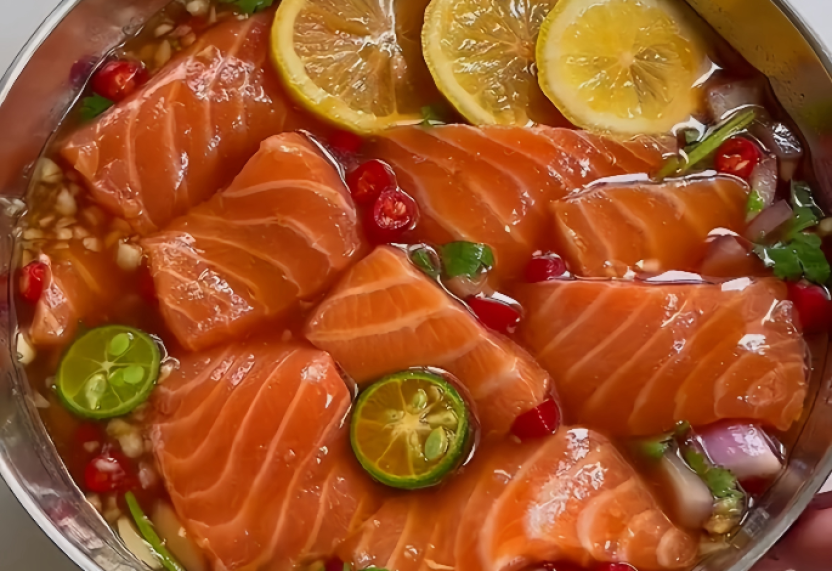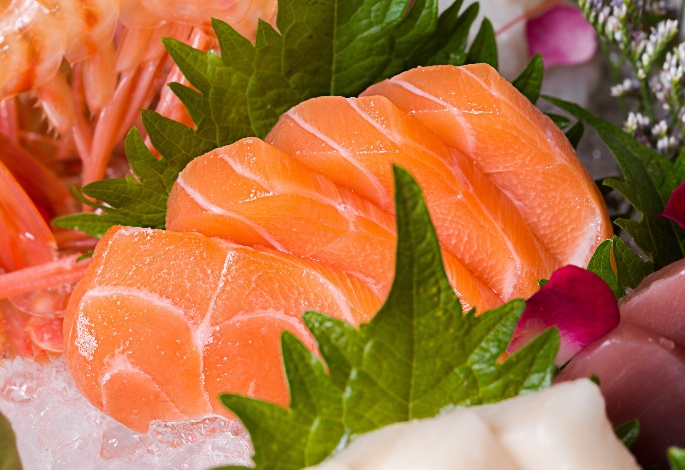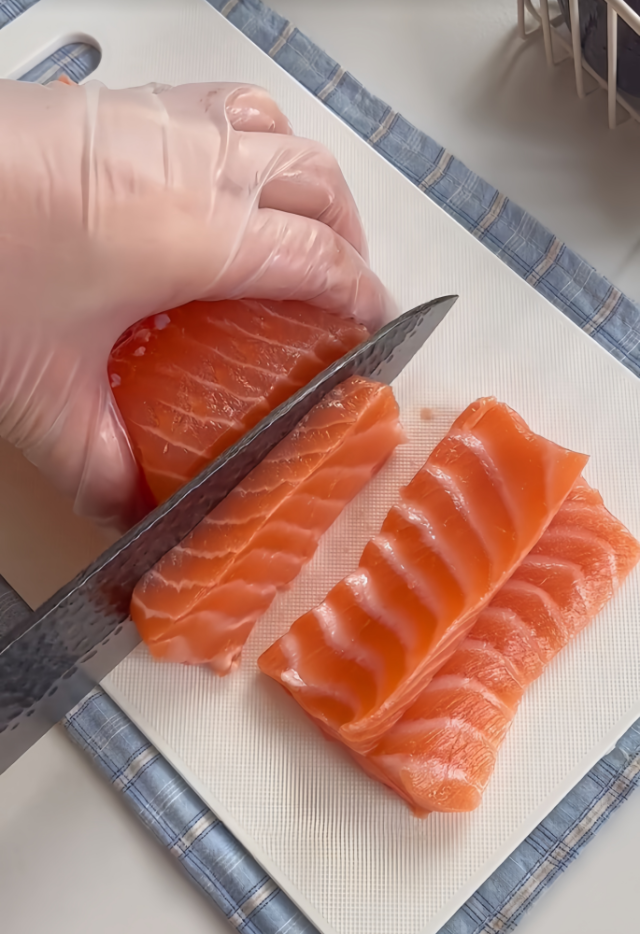Thai Salmon Salad
Lack of appetite in the hot summer? Then you mustn't miss this Thai-style cold salmon salad today. Now let's make this delicious dish together!

 2 Comments
2 Comments
About Thai Salmon Salad
Thai Salmon Salad is a classic Thai salad dish. It is made with salmon as the main ingredient and mixed with chili pepper, lemon, coriander and other ingredients. It tastes sour and spicy and appetizing, and well preserves the fresh taste of salmon.The Thai Salmon Salad can be prepared in a variety of ways. You can add coconut milk or coconut sugar to adjust the taste according to your own taste. It is popular all over the world.
Ingredients Needed
Salmon: The main ingredient, providing a tender taste and rich protein.
Diced onions, minced garlic, minced coriander, and diced millet peppers: Provide a special fragrance and spiciness to enhance the overall taste of the dish.
Slices of lime and yellow lemon, lemon juice: Mainly used for flavoring, providing a sour and sweet taste, and are essential for Thai-style cold dishes.
Light soy sauce, sugar: Light soy sauce increases the saltiness and color of the dish. Sugar provides sweetness to balance the sourness.
Wasabi: Provides a stimulating and spicy taste to help enhance the flavor of the dish.
How to choose salmon
Observe the color: When buying salmon, you should choose fresh salmon. Fresh salmon should be orange-red or dark red, shiny on the surface, and evenly distributed in fat. If the salmon is dull, or has spots, brown spots and other abnormalities, it is not fresh and is not recommended.

Smell the smell: When buying salmon, you can also judge the quality by smell. Although fresh salmon has a fishy smell, it has no peculiar smell. If the salmon has a bad smell, moldy smell or other peculiar smell, it indicates that it is of poor quality.
Touch the texture: Fresh salmon has firm and elastic meat. After gently pressing with your fingers, it can quickly return to its original shape; if the salmon meat is loose, soft or loses elasticity, it is not fresh or has deteriorated.
Check the appearance: If you buy a whole salmon, you need to check whether the skin and scales are intact and shiny. Fish eyes should be clear and transparent, not turbid; fish gills should be bright red, with red mucus, and clear structure without confusion; at the same time, the surface of salmon should be moist and not dry, which is an important indicator for judging the freshness of salmon.
Understand the origin and brand: Salmon from different origins and brands may differ in quality and taste. Salmon from Norway, New Zealand, Faroe Islands, Denmark, etc. are of higher quality and delicious taste.
Salmon handling techniques
Before handling salmon, thoroughly wash your hands with soap to avoid residual dirt.
Use a clean new cutting board and knife to cut salmon to avoid cross-flavors.
The bought salmon should be kept in the refrigerator and should be consumed as soon as possible after handling.
If you want to thaw frozen salmon, wrap it in paper towels and then thaw it in the refrigerator. Thawing salmon in the refrigerator can ensure that salmon does not reach the "dangerous" temperature (room temperature) during thawing, and the paper towels will help absorb the excess liquid that flows out.
INGREDIENTS
MAIN INGREDIENTS
- 500g salmon
ACCESSORIES
- 20g diced onions
- 20g minced garlic
- 30g minced coriander
- 20g diced millet peppers
- 2 slices of lime
- 3 slices of yellow lemon
SEASONINGS
- 2 tablespoons light soy sauce
- 30 milliliters lemon juice
- Half a tablespoon sugar
- 5g wasabi
- 200 milliliters cooled boiled water
DIRECTIONS
STEP 1
Salmon handling:
Wash 500 grams of salmon carefully with clean water, drain the water and cut it into slices for later use.

STEP 2
Sauce preparation:
Put 20 grams of diced onions, 20 grams of minced garlic, an appropriate amount of minced coriander, an appropriate amount of diced millet peppers, slices of lime, and slices of yellow lemon in a bowl in turn. Then pour in 2 tablespoons of light soy sauce, half a tablespoon of sugar, 5 grams of wasabi, 30 milliliters of lemon juice and 200 milliliters of cooled boiled water. Use a stirring tool to fully stir evenly. Set aside the prepared sauce for later use.

STEP 3
Finished product production:
Pour all the sliced salmon into the prepared sauce and stir evenly again to make the salmon fully coated with the sauce to complete the production.

More salad recipes worth trying
Recipe Tips
In terms of storage and consumption
Storage
Thai-style cold salmon salad is not recommended to be stored overnight. After overnight, it is easy to breed bacteria and other harmful substances. It is recommended to eat it freshly made. Salmon is relatively easy to deteriorate. If it really needs to be stored, it must be placed in a sealed container and put in the refrigerator's refrigeration compartment and consumed within one day.
Combined consumption
Thai-style cold salmon salad can be eaten with rice, such as Thai fragrant rice, rice noodles, etc., so as to better experience the Thai flavor. It can also be eaten with some vegetable salads to make the nutrition more balanced.
Can I substitute another kind of fish or seafood?
Yes, other types of fish or seafood can be used instead of salmon as long as it is ensured that the substituted fish or seafood can be safely eaten raw. For example, scallops, tuna, etc. are all possible.
Recipe analyzer
- Recipes: Thai Salmon Salad
- Main Ingredients:7
- Servings per recipe:1
- Servings size:822 g
-
Energy (calories):870 kcal
-
Protein:106.49 g
-
Fat:36.57 g
Why gray?

-
Carbohydrates:28.46 g
-
Protein: 52%450 kcal
-
Fat: 38%329 kcal
-
Carbohydrates: 10%89 kcal

The ratio shows whether the proportion of both fatty acids in your diet is optimal. Red color means too much of Omega 6 or too little of Omega 3. The data are rounded off and approximate.











2 REVIEWS